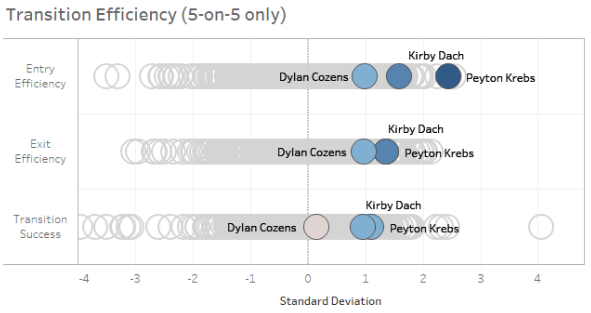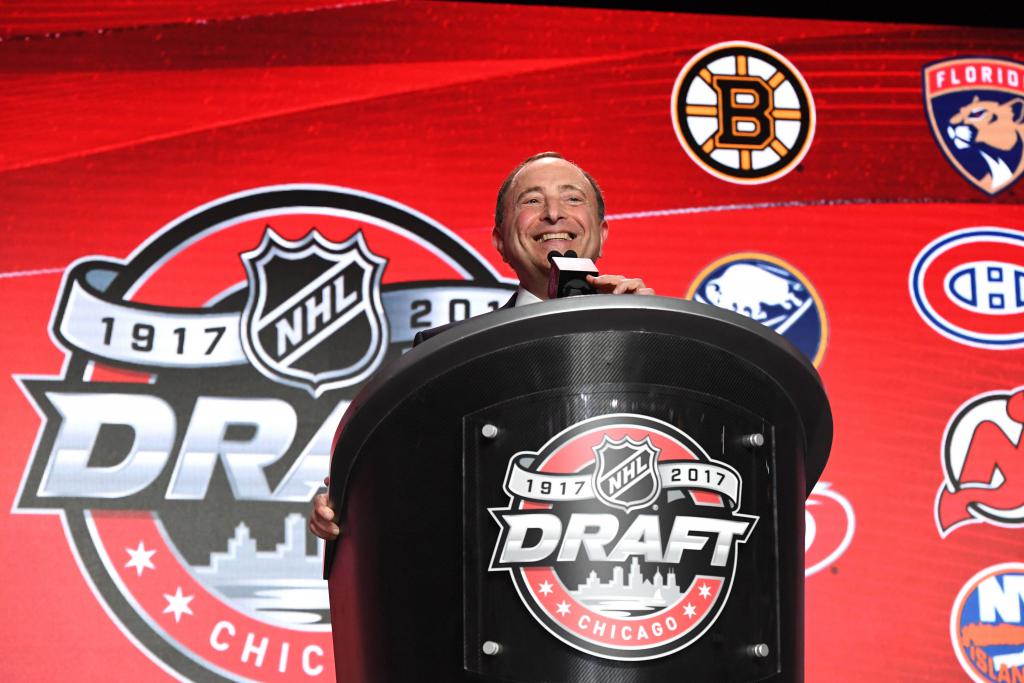BROWN: Comparing WHL’s top prospects; Dylan Cozens, Kirby Dach, & Peyton Krebs

Throughout this past season, my favourite draft debate has been, “Dylan Cozens, Kirby Dach, or Peyton Krebs?”
The three WHL centres all project as potential top-six pivots. All three have a legitimate argument for being a better prospect than the others; all three bring a unique style of game.
In this piece, I’m going to toss my hat into the ring. This article will rely heavily on EP’s Microstat database. I tracked 14 of Cozens’ games and 13 of Dach’s and Krebs’ games to enhance my understanding of their ability.
I’ll break the comparison down into four categories: shooting, passing, transition, and defence. Then, I use their inputs (i.e., skating, stickhandling, other microstats) to compare the results that the prospects are generating.
Shooting
Of the five categories discussed, shooting is the only one that’s uncontested. The best shooter of three is Cozens. He’s also the best finisher and best at generating scoring chances — however, none of the trio projects as top-level goal-scorers or long-range snipers.
Cozens scored 34 goals this season, compared to 25 for Dach and 19 for Krebs. At 5-on-5, Cozens 0.37 goals per game were 14th in the WHL, while Dach’s 0.32 was quite close. On the other hand, Krebs scored just 0.16 5-on-5 goals per game, albeit with a much weaker supporting cast.
Expected Goals per 60, a measure of the likelihood of a goal given the shot type, location, and passes preceding the shot, also has Cozens in the lead — this time by a significant margin. Cozens is on the cusp of the CHL’s elite in xG/60, scoring two full standard deviations above average. Dach and Krebs are much further behind, at 0.65 and 0.6 standard deviations above average.

While Dach and Krebs are puck handlers and playmakers, Cozens is a shooter. He relies on his teammates to get him the puck, but don’t underestimate his ability to generate offence off-the-puck. He’s a highly selective shooter, rarely shooting from beyond scoring chance location (I tracked 73 percent of his shot attempts as scoring chances).
It’s Cozens’ offensive feel that makes him so effective around the goal, more so than skill. That is, it’s timing and ability to get open that makes him so effective.
Cozens can score from range, but he’s not launching pucks off the bar and in. Instead, his preference is to shoot low and then hunt down the resulting rebounds. His release is short and quick on his wrister, and he’s an avid user of the snap and one-time shots. He can shoot while pressured, but Cozens doesn’t have the variety of release points or weight shifts that NHL snipers do.
After Cozens, I’d rank Dach as the next-best shooter. With 46 percent of his shots (compared Cozens’ 73 percent) coming from scoring chance areas, there are reasons to believe that he doesn’t generate the same quality of chances as Cozens. He’s also limited to just one shot (wrist), which limits his overall variety. However, Dach’s a clever shooter, often aiming over the shoulder, between the arms and body, or against the grain from sharp angles. Throughout the season, he became more aggressive taking the puck to the net.
Krebs isn’t so much an average shooter as he an average player at getting to the high-danger portions of the ice. His offensive feel on the playmaking side doesn’t transfer to the shooting side. He’ll pick a corner from range, but lacks additional layers or traits that make his shot a strength.
Passing
If Cozens is the best shooter, with Dach and Krebs far behind, then the opposite is true for playmaking. In these samples, Dach and Krebs finished with virtually identical Expected Primary Assists per 60 rates, 1.9 standard deviations above average. Meanwhile, Cozens finished with a pedestrian 0.27 at 5-on-5.

Looking at the chart, it’s shocking that Krebs even compares to Dach, given the total lack of shooting talent that available to Krebs on Kootenay. I could see an argument for both Dach and Krebs being the top passer of the group, so I’ll present an argument for each.
The argument in favour of Dach is the uniqueness of his playmaking ability. At 6-foot-4, with a soft touch, defenders bounce off Dach along the boards as he sets up targets in the slot. He combines that length with a high-grip stickhandling style that allows him to extend to hook passes around reaching defenders. He consistently hits targets in short range in creative, effective ways. He’s also one of the best transitional playmakers I’ve seen in the CHL, consistently hitting his teammates with two-line passes.
Dach’s constantly throwing passes around the slot from all directions hoping to hit a target. The trade-off is he’s often throwing away opportunities with low-percentage plays rather than taking a shot. Fortunately, his shooting/passing balance improved in the second half of the season.
For Krebs, the argument is pass type, context, and layers. While Dach’s primary passing method is hitting teammates into the slot, Krebs’ is connecting across the slot. While this distinction might seem trivial, a shot following a pass into the slot (hash marks and in) has a shooting percentage of 22. A shot across the slot has a shooting percentage of 34, before accounting for shot type (one-timer increases the shooting percentage). Even though Krebs’ had less talent around him than Dach, that distinction meant that Krebs, with fewer shot assists, was able to generate the same xA1/60. This matters, because cross-slot passes, just like in junior, carry in the NHL, too.
A lane creator through and through, Krebs uses his skating and handling to attract multiple defenders to find an open teammate. He then adds layers to his passes, using look-offs and fakes to deceive defenders, or hitting moving targets. The results of such a layered approach to playmaking are some of the best passes I’ve seen all season.
I’d give Krebs the edge because I prefer the projection of his passing, but I understand both arguments.
Cozens isn’t the playmaker the other two are, although I do think his passing skill is above-average despite the results. He’s a capable passer around the goal, and his creativity will surprise. However, his vision is limited across the rest of the ice.
Transition
Transition is the least cut-and-dry dimension of the debate. All three players have realistic claims to the transition throne, all for very different reasons.
Projection-wise, Cozens is the strongest transitional prospect. He has separation speed and a high-tempo style. He’s selective with his speed, drawing in defenders by slowing down, then speeding up once they lose their momentum. He skirts past checks with one-step acceleration. That level of skating is rare. Not for a 6-foot-3 centre — rare, period.
I chose “projection-wise” for a reason. Those dynamic rushes aren’t what Cozens is doing every game. Instead, he attacks the outside too much. Often, he’s the reason his rushes fail because he skates himself into trouble without an escape plan. Despite his flaws while in possession, he’s strong as an off-the-puck skater, using his speed to back off defenders to create space for his teammates.
The transition data also suggests some concerns about his on-the-puck transitional play are justified. In our three transition categories, Cozens sits behind Dach and Krebs.

Cozens is the most likely to use a dump or chip to exit the defensive zone and gain the offensive zone (Exit & Entry Efficiency, both relative to the team). To his credit, he does lead Lethbridge in recovered dump-ins. He’s successful on a merely average rate of his transitional plays, which is disappointing for a player with that level of skating and handling ability.
While Dach and Krebs don’t possess Cozens’ skating ability (although both have separation speed in their own right), they’re more frequent and successful puck carriers.
Krebs is the best transition player of the trio at this level. His 83 percent Entry Efficiency (a.k.a., Controlled Entry Percentage) is 40 percent above Kootenay average, good for the second-highest relative rate in my entire data set. He’s allergic to dumping the puck in.
While Krebs’ skill, especially the handling and speed, are on display in the clips below, it’s really the rush habits that separate Krebs here. There’s variety in these rushes, but there are a few constants:
- Krebs attacks with pace, building up speed throughout the rush.
- He changes the angle of attack throughout the rush, using a combination of crossovers and strides to remain agile as he determines the preferred route.
- He changes speed throughout the rush, accelerating into open ice and slowing down once defenders get close.
These three traits make it near impossible for defenders to stop Krebs. He’s too fast, too deceptive, and too agile for defenders to keep up. Often, it requires a double or triple team just to get Krebs to dump the puck or pass to a teammate. He’s that good in transition.
One of the most gifted handlers in the draft, Dach unsurprisingly relies on his hands more than Krebs. He handles the puck with his hands at the top of his stick, allowing him to make full use of his reach. While this high-grip handling reduces a player’s strength on their stick, Dach can box out reaching defenders or comically throw them off with one hand.
Like Krebs, he constantly changes the angle of attack during his rushes, faking middle drives to cut wide, and vice-versa. His rushes are even more dependent on crossovers than Krebs’, which gives Dach this added deceptiveness to his moves. Combined with flashy moves and advanced outside edge control, Dach rushes are a rare blend of power and skill.
Where Krebs gets the edge over Dach is in the off-the-puck habits and pace. Both players are avid transition passers, but Krebs finds a way to stay involved after off-loading. Sometimes it’s a net drive to open a lane; others, it’s cutting across the slot to open up a shot. Dach tends to more passive, hanging around the perimeter, waiting for a return feed. Additionally, both on and off-the-puck, Dach can be too reliant on slowing the play down in transition, showing a lack of pace on occasion.
Defence
Defence is always the trickiest part of any evaluation. Truthfully, I’m skeptical of defence metrics due to a lack of a nuanced context. Additionally, our eyes lie; they lie all the time. Generally, the best defenders defend infrequently, which introduces the problem of sample size. And defence, in my understanding, is an absence of something. It’s really hard to train to your eyes to watch something that isn’t occurring. I would know — I’ve tried.
Now, take the most misunderstood and under-researched part of hockey, and combine it with projecting a different level. That’s complex. Unless there’s some overwhelming pile of evidence in favour, projecting defensive ability gets too complicated with too much uncertainty.
So, when I look at defence in prospect evaluation, I look for the extreme. Sure, I’ll point out little defensive details that I think matter, and need improvement, but they won’t change my projection of a prospect. I look at the players who are doing some truly noteworthy defensively; doing it consistently against all levels of teammates and opposition, with a heap of caution applied.
The good news: there’s one player in this piece that does fall into the extreme of some defensive metric. That player is Dach, and that metric is backchecking.
The chart below shows “Neutral Zone Involvement,” which the sum of steals on the backcheck, prevented entries against, and recovered defensive zone dump ins by the opposition. Rather than rate it on a per 60 minutes scale, I’ve chosen to use per Corsi Against. Choosing this scale prevents players who spend a lot of time defending from having high scores; instead, it puts everyone on the same playing field.

Now, you might notice there is no Dach on the chart. That’s because he’s way off to the right. He’s 5.5 standard deviations above average in our backchecking metric. Kristaps Porzingis, 7-foot-3 basketball superstar, is 5.5 standard deviations above average height. I’m saying Dach is very far away from average.
Dach’s steals on the backcheck per Corsi Against ranks third of Saskatoon’s nine eligible defencemen. He’s another defender out there, using his length, closing speed, and lizard tongue-like hockey stick to break up plays. He just about always takes the extra ensure that he can strip away possession and begin the rush up the other way.
Cozens and Krebs both bring some defensive value. Krebs, like Dach, is a high-energy defender on the backcheck and a strong support player.
Conclusion
There are legitimate arguments to be made for all three prospects over the others. They excel in different ways; Cozens as the projectable goal-scorer; Dach as the sizable playmaking, workhorse centre; Krebs as the pacey centre with top-end playmaking.
Of course, one must consider the context, particularly Krebs’ unique supporting cast. His two most common linemates had career-highs of ten and seven goals until this season. Krebs turned them into 28 and 16 goal-scorers respectively. Kootenay won just 13 games this season, getting outscored by 143 goals along the way. There haven’t been any high-end CHL prospects with that weak of a supporting cast in the past decade, save for maybe Brett Connolly, who played 19 games.
All three prospects have high-skill profiles. I don’t think that one can go wrong with any of them. I, however, am a man of opinion. So, here’s my order ranking of the WHL’s top three prospects:
- Kirby Dach
- Peyton Krebs
- Dylan Cozens
I rank Dach first because I believe his skill level is the highest. He’s right up there with Krebs as the top playmaker, and if his second-half is anything to go by, he’s not too far off from Cozens’ goal-scoring upside. His unique blend of puck protection, skill, and vision could make one of the NHL’s most versatile centres for years to come. He also brings a defensive value that the other two can’t match. For Dach to take his game to the next level, I think he needs to attack with a bit more pace and iron out the inconsistencies in his game. His progression on both fronts has been encouraging.
Krebs is second on my list because his skill level is the second-highest. He lacks the puckhandling and shooting of Dach. While Krebs is the better playmaker, at least in my sample, the difference is minuscule. The x-factor here is context. His weak team undoubtedly prevents his skill set from shining its brightest. If one makes a heavier adjustment for context than myself, I see a compelling argument for Krebs to be first.
Coming third, but certainly not without much consideration, is Cozens. The projection is what’s enticing about Cozens: hard skill, breakaway speed, goal-scoring instincts. But he’s not the dynamic play-driver that Dach and Krebs are. So, I ask myself, “How likely is it that Cozens evolves to make use of those tools?” And I think the answer is unlikely. Even if that doesn’t happen, I still confident that he’s a potential top-six forward. But until I see more skill, he’s behind Dach and Krebs for me, just by a hair.
Overall, all three prospects provide an intriguing skill set with top-six upside. I look forward to the Cozens, Dach, or Krebs debate continuing in the NHL for years to come.


